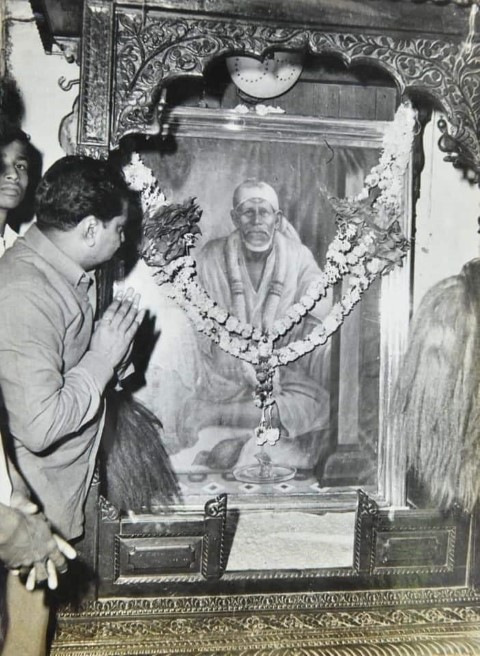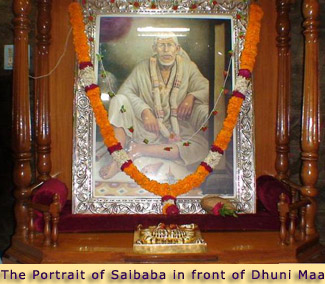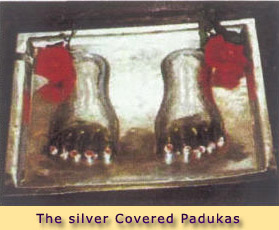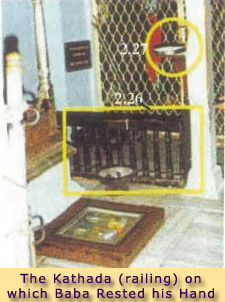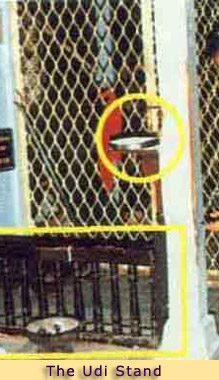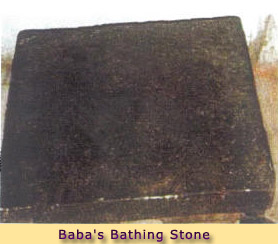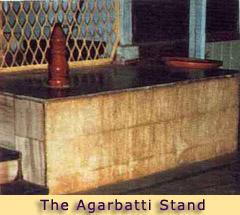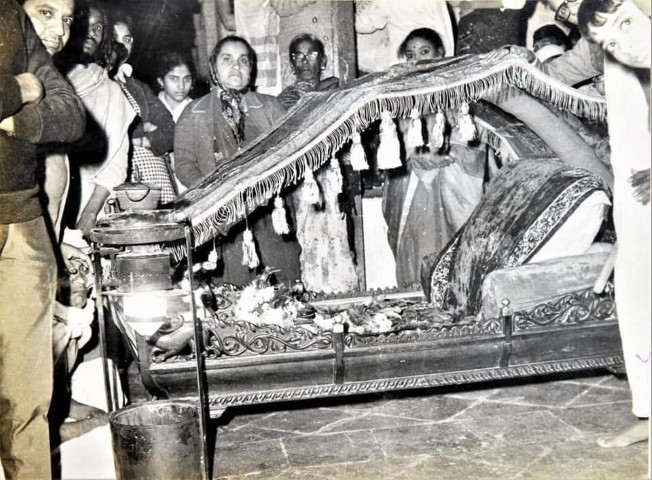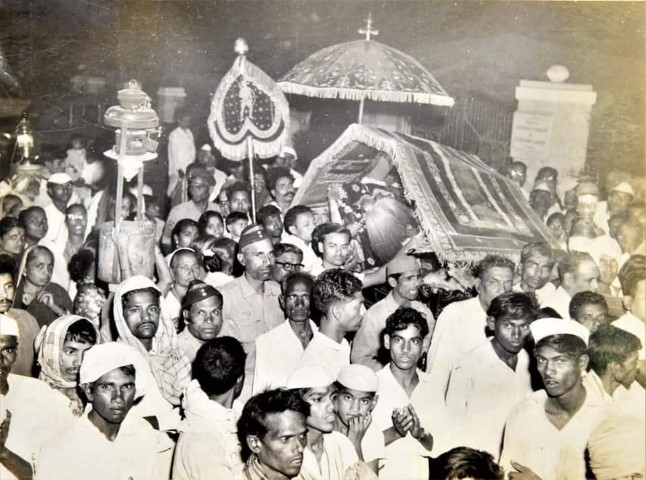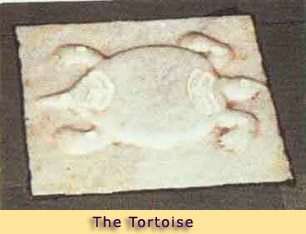DWARAKAMAI (MASJID) |
||
THE PORTRAIT OF SAIBABA IN FRONT OF DHUNI MAA (DWARAKAMAI POSE) This portrait is an oil painting by the famous artist Shyamrao Ramachandra Jaikar. Moreshwar Pradhan had brought Jaikar to Shirdi and requested him to make two portraits of Baba. After Jaikar met Baba, he on his own accord made more than two paintings, at Baba's bidding, when Baba said "Aur Banao Jyada Banao, main galli-galli mein rahnewalla hoon" (Make more. I shall be residing in every street).
Old Picture of Dwarakamai Baba (Photo Courtesy: Shri.Nandakumar Revannath Deshpande Nimonkar)
This portrait was presented to the Sansthan after Baba’s Mahasamadhi. It was installed in the very place where Baba sat. As the portrait was created with Baba’s consent it has this incredible feature that when a devotee looks at it with love and devotion, he gets the “living experience” of Baba in it. Many a devotee has had unimaginable, and innumerable Leelas from this painting. The devotees could not leave Shirdi without Baba's permission. When they wanted to leave they came to Baba in the Dwarakamai and sought his permission. Baba gave them Udi and his blessings and they had a safe journey. Even today devotees go to this portrait, prostrate asking for His permission and then take the Udi and leave thus having a successful and safe journey. At present, the original painting done by Shyamrao Ramachandra Jaikar is kept in the Museum. The one that is seen now in Dwarakamai is a copy of the original painting. This famous and beautiful portrait is a masterpiece and is widely known as “The Dwarakamai Baba Pose”. Every night the priest places a Kalasha filled with water, and a kerosene oil lantern that is lit. The portrait is covered with a mosquito net. It is believed that when a human being sleeps the atman leaves the body and travels about here and there. Finally, it comes back to the body; water is binding force that helps it to identify the proper body. The light from the lantern does the same. The Possible Meaning of the Dwarakamai Pose Baba is sitting next to the railing, and His silhouette is in the form of a triangle with the apex at His head with the Bilva leaf on it. It signifies Mount Meru the abode of mother Parvati. So He is the mother calling His children (us) to come and take refuge in Him. The Kakad Aarti says, “Tu Shanti Kshamecha Meru Ho. Tu Bhavarnaviche Taaru Guruvara" (You are the mountain Meru of peace and forgiveness. You are the bark that ferries us across this mundane existence). By this posture Baba is instructing us to totally surrender at His lotus feet. This is done by offering the Pancha Pranas, Arishadvargas, Trigunas, Karmendriyas and Jnanendriyas represented by the five fingers of the left hand. Manas, Budhi and Chitta are represented by the three fingers of the right hand that are not visible. The index finger is pointing down representing Aham (Pride and Ego). The thumb represents the Sadguru or Parabrahma which is turned in pointing to Himself. It is the Sadguru or Parabrahma who can cleanse the Jeevatma of all impurities and undesirable traits. This is total surrender to His lotus feet. He is not only assuring us but also promising us (represented by his firmly placed right foot) that He will take us on His lap, represented by His left foot. Thus, this pose is an assurance that He is prepared to take us on His lap like a mother, provided we surrender to Him in toto. THE SILVER COVERED PADUKAS IN FRONT OF BABA'S PORTRAIT In front of the portrait painted by Shyamrao Ramachandra Jaikar, is a pair of silver covered Padukas. They were mounted in a granite platform about 3” above the floor. After Baba's Mahasamadhi, Shyama was staying in the Dixit Wada. The Sansthan was formed and Shyama was asked to pay rent. Shyama however, left Dixit Wada and took along with him Baba's Padukas and Photograph to his house. The Sansthan requested Shyama to return them but he refused at first. Then S.B. Dhumal went to his house with a big procession and Shyama handed over all the articles.
These Padukas are worshipped daily in the morning by the Pujari of the Dwarakamai and decorated with ashtagandh. The Pujari of Samadhi Mandir comes to the Dwarakamai between 11.30 and 12.00 noon to perform Vaishva Deva Puja. He cleans Baba’s photograph and the padukas and applies fresh ashtagandh. Now these padukas are installed on a pedestal about 3’ high and are covered with gold foil. Devotees offer their “Sashtang Namaskar” to these holy Padukas. THE KATHADA (RAILING) ON WHICH BABA RESTED HIS HAND This is the railing on which Baba rested His left hand. Baba sat near the wall of the Masjid facing south (towards Dhuni) but He did not lean against it. He always sat upright. In the north east corner Baba sat in the direction of Ishaanya. His leg outstretched, showing His blessings on the devotees. There are eight directions or quarters in this world, each, presided and protected by a deity or Dikpalaka. Baba sat in the north east corner which is protected by Ishaana whose vehicle is an Ox. This symbolizes that each individual goes a certain direction, or follows a certain path that makes or mars his life, according to his vasans. It is lord Ishaana who guides the world. He will come riding on the Ox or Vrishabha to exhaust the accumulated vasanas of the jeevas. Thus, Baba sitting in the North East direction guides the individual in the right direction. Therefore, any Puja starts with Ashta Digbhandana (the Eight Direction Bondage). Then the mind of the individual is arrested from taking any particular direction and he discovers his own true nature.
Baba sat facing the south; he is Dakshinamoorthy. The south is the special domain of lord Yama. Yama means control; it can be self-control, as well as a limitation over ones’ capacity. The ever smiling, Guru, Saibaba symbolizes the fact that a man of realization has transcended time. That the Guru’s grace is being showered on the devotees who are caught in the net of Yama, the lord of death. The Guru leads the disciple to immortality. This railing has been painted over and over again but if one lovingly rests one's forehead on the railing, one can feel a gentle depression where Baba probably rested His hand. Recently the Sansthan have placed a plastic cover over the whole railing. Baba’s Asana Dixit was concerned about Baba sitting on the cold floor. It got so cold in winter that it was impossible to stand on the tiles that he had laid. Baba sat on the floor for hours together. As Baba would not accept a cotton mattress, immediately he set out and made a mattress of sack cloth. This Baba did not object to. That evening after his rounds, Baba asked them to remove the mattress. So every evening Dixit would take the mattress to his Wada, and return with it early next morning. So the sack mattress became Baba’s Asana. Baba usually sat on a piece of sack cloth but His bhaktas lovingly placed a Gaadi over it and bolsters for Him to rest. Baba usually sat with His legs outstretched and His left hand rested on this railing. (Refer Sai Leela Magazine, Margashirsha Shake 1857 year 12 (1936)). THE UDI STAND The Kathada (railing) is attached to a pillar and to this pillar the Udi stand or container was fixed. Udi, the sacred ash that came from Baba’s Dhuni Maa was plentiful and Baba gave a palm full of Udi to his devotees. This Udi is called as “Angara, Rakh, Bhasma or Vibhuti”. It is the gift of Dhuni Maa. That wonderful Dhuni Maa that Baba lit when he came to stay in the Dwarakamai. The meaning of Udi is detachment based on discriminating knowledge. The literal meaning of Udi is 'to go'. Baba gave Udi to His devotees with blessings that they should go to a higher plane in their spiritual endeavor. When Baba was in a cheerful mood he used to sing in a melodious voice merrily about the sacred Udi "Ramte Ram, Ramte Ram, Avo Ji, Avo Ji, Udiya Ki Guniya Lavo Ji, Lavo Ji" meaning “Shri Rama has come. He has come during his wanderings. And he has brought bags full of Udi”. "All the visible phenomenon in this Universe are as transient as ashes and hence one must use discrimination" taught Baba. The Akhand Dhuni Maa is yielding abundant Udi even now and will continue to do so till the end of time. (Refer Shri Sai Satcharitra, Chapter 33).
During the early days of his stay in Shirdi, Baba gave medicines to the sick people without accepting any payment from anybody. But after few years, he stopped dispensing medicines and started giving Udi instead. Baba used to give Udi to the devotees after the Aarti and also at the time of departure. Udi has healing powers, during Baba's time it was used for scorpion sting, bubonic plague and the 'Jamner miracle,' just to mention a few. The power of the Udi is as potent as before, and is still curing the diseases and Karmic impediments. In the Shri Sai Satcharitra, Chapter 33 and 44, the leelas and greatness of the Udi is given beautifully. Baba went into the forests around Shirdi and brought wood for the Dhuni Maa. Sometimes he went to forests far away, and brought huge logs of wood. This he did himself; there was always a stack of logs near the Dwarakamai. These logs he fed to his Dhuni, and the ash or Udi he applied to devotee’s forehead. Vibhuti means “all pervading” or omnipresent. Baba had a unique way of applying Udi. He often took the Udi between his thumb and forefinger and applied it exactly in the centre between the eyebrows. This spot is the Trikuti or the third eye. It is the house of Brahman. Brahman enables you to get self-realization or realize the true self. This spot is also where the Ajna Chakra is seated, when the kundalini is awakened. Baba pressed his thumb laden with Udi on this Ajna Chakra and then drew his thumb in an upward direction. Baba also used to refer to this spot as the 17th Kala. In the Prashna Upanishad of Atharva Veda, 6th Chapter, a mention has been made about 16 attributes of a person known as “Shodasha Kala”. Though a Purusha is made up of 16 attributes he is perpetually searching for the truth and wants to realize the atman. He cannot achieve it as he is submerged in Maya. Only the Sadguru with his grace can show him the right path. Baba by applying Bhasma or Udi on the Ajna Chakra, the centre of the principle of the mind, makes the Purusha understand that he is drowned in maya. And that this transient world will one day be reduced to ashes. Thus Baba is instructing us to treat Bhasma as a path leading to Vibhuti or the all pervading (Parabrahma). This can be accomplished through Dharana, i.e., fixing the mind on him; Dhyana (meditating on him) which results in Samadhi (super conscious experience). In order to get released from the bondage of Maya, develop Samyama or control of the mind by applying Udi. The word Bhasma means sacred ash, representing the transient nature of the universe. One day, all existing things will burn to ashes. The wise do not develop any attachment to them. The use of Bhasma on the body ought to remind us of the transient nature of the world, so we should contemplate on the permanent or the Parabrahma. Devotees may apply this Udi daily and take it as Tirth which will eradicate their Karma, diseases, fulfill their wishes and help them in their spiritual path. BABA'S BATHING STONE This stone was prepared by Rambaji of Nasik. Hearing of Baba's Leelas he came to Shirdi in a mentally disordered condition. He used to drink Baba's bath water and used it on his body. By doing so he got rid of his mental disorder. As a reminiscence of this he gratefully prepared this stone and offered it to Baba to sit and have bath on it.
This bathing stone was kept in the verandah of the Dwaraka Mai. After the Museum was opened the bathing stone been housed in the hall on the ground floor of the Museum. THE THREE STEPS NEXT TO THE OTA OR PLATFORM The three steps of Dwarakamai lead into the Sanctum Sanctorum. These 3 steps are now used to exit the Sanctum Sanctorum. Whenever Baba went for Bhiksha rounds or to Lendi Bagh and returned, he washed his feet and hands known as Upa Snan on these steps. Many devotees waited for this ritual to complete so that they could collect the water that flowed from his feet as Paada Teertha. This they drank and took home and distributed, for they knew that it would cure many physical and mental afflictions. THE OTA OR PLATFORM WITH THE AGARBATTI STAND There is a small red Agarbatti (incense stick) stand attached to the platform. This platform is on the right side of the main entrance of the Dwarakamai. It is about 8’ long and 3-1/2 ‘ wide and has a height of 2-1/2’. The devotees would offer incense sticks to Baba. Then light them and fix them on this stand.
Baba often sat on this platform and distributed Udi after the Noon Arati. There is an original photograph of Him sitting on this platform. THE PALKHI ROOM This room is on the right side of the main entrance of Dwarakamai. Due to the efforts of Radhakrishna Mai, Shirdi was turned into a Sansthan. In 1912 a Palkhi, Rath, many silver utensils and pots were presented. Once this Palkhi was left outside and some of the silver ornaments were stolen. The distraught devotees ran to Baba and complained and Baba simply said "Why did the thieves not take away the whole Palkhi?". So Purandhare and Radhakrishna Aai decided to make a room for it. Purandhare dared to put up the rafters after making five to six holes in the wall of Dwarakamai for support and the Palkhi was kept there. This Palkhi was presented by Sadu Bhayya Nayak of Harda.
Old Picture of Palkhi (Photo Courtesy: Shri.Nandakumar Revannath Deshpande Nimonkar) Baba never sat in the Palki, but his photo was placed on it. Every Thursday at 9.15 PM the Palki is brought in procession to Chavadi.
Palkhi Procession during earlier days (Photo Courtesy: Shri.Nandakumar Revannath Deshpande Nimonkar) THE TORTOISE This marble tortoise is in the center of the well. The black tiles surrounding it represent the four flights of steps leading to the bottom of the well. Numerous meanings are attached to this tortoise. (1) The tortoise is an 'avatar' of Vishnu (Kurma Avatar) (2) That one should enter the place of worship like the tortoise bowing one's head, in complete surrender. Leaving the ego outside just as the tortoise in a prostrate position; one should surrender everything to Baba; (3) But most importantly the tortoise is looking at Baba and if we follow her example and look towards Baba, He will surely look after us (Eleven sayings of Baba).
In Chapter 19 of Shri Sai Satcharitra Baba gives the analogy of the tortoise and says "Just as the mother tortoise feeds her young ones by her loving glances so was the way of my Guru. The mother tortoise is on this bank and her little ones are on the other bank. They are nurtured and reared just by her loving glances”. This tortoise is worshipped with “asthagandh” before “Kakad Aarti” and after 11.30 AM before “Noon Aarti”. |
||
(Courtesy: Ambrosia in Shirdi and Baba’s Gurukul by Vinny Chitluri). |
||
© 2011 Saiamrithadhara.com. All Rights Reserved. |
